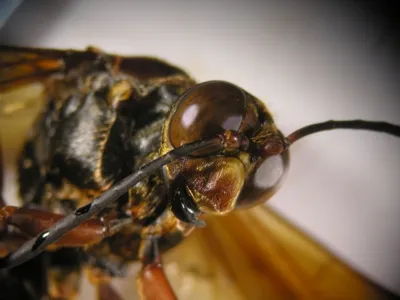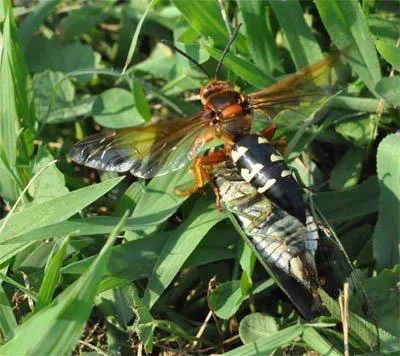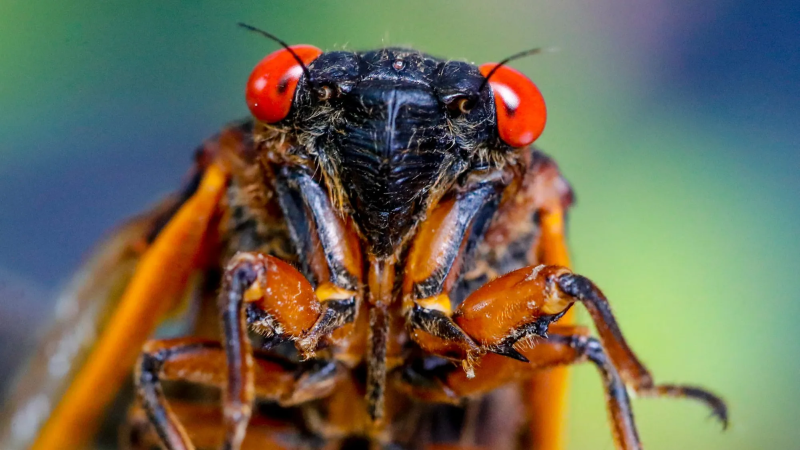Beware the cicada killer: 2024 broods will need to watch out for this murderous wasp
When the trillions of periodical cicadas emerge in multiple Midwestern and Southeastern states next month, they will face a unique predator with murderous intent: Cicada killer wasps.
Cicada killer wasps, also known as the eastern cicada killer or cicada hawks, are a species of the large digger wasp that preys on cicadas. This is bad news for the Broods XIX and XIII, which are set to emerge in mid-to-late May in a number of states in a rare, double-brood event that hasn't happened since 1803.
While cicada killer wasps will likely feed on the two broods, they are also known to sting humans and disturb lawns.
Here's what you should know about the cicada killer wasp.
The cicadas are coming:Check out a 2024 map of where the two broods will emerge
What is the cicada killer wasp?

Cicada killer wasps are approximately two inches long, according to the Smithsonian, and are black or dark brown with colorful yellow markings on their abdomen.
Eastern cicada killers (Sphecius speciosus) are one species in the Sphecius genus, found east of the Rocky Mountains, per the Smithsonian. Another species, Sphecius convallis, is known as the western cicada killer.
Adult cicada killers appear around late June or July, and are mostly seen around flowers or digging burrows in sandy or light soil, according to the Smithsonian.
What do cicada killer wasps do?
True to their name, cicada killer wasps make their nests in the ground and feed cicadas to their young.
According to the Smithsonian, a female cicada killer finds her cicada prey in trees, and captures them in flight, paralyzing them with a venomous sting. The female will then carry a cicada back to her underground nest, where the paralyzed cicada prey will remain alive while the wasp larvae feed.
To feed her young, the female cicada killer will lay one egg in a cell filled with one to three cicadas, then will seal the chamber, leaving enough food for the larvae to survive until pupation. The larvae usually feed for about two weeks before they make a cocoon, which remain in the cells through the winter and emerge as adults in the following summer.

Do cicada killer wasps sting? Can they hurt humans?
Cicada killers are solitary wasps, the Smithsonian says, but they can disturb lawns with their burrows and will also sting if they are bothered.
While males have a pseudo stinger on their abdomen, they cannot sting, according to Texas A&M Extension, and females only sting if they are threatened. They do not attack people, but are territorial around their underground nests or females.
Are cicada killer wasps bad for lawns?
Since killer wasps make their nests underground, they could cause damage to lawns by burrowing underground. They are considered minor pests and are not dangerous to humans unless they feel threatened.

Broods XIX and XIII: Check out the 2024 cicada map
The two broods will emerge in a combined 17 states across the Southeast and Midwest, with an overlap in parts of Illinois and Iowa. They will emerge once the soil 8 inches underground reaches 64 degrees, beginning in mid-May and lasting through late June.
The two broods last emerged in 1803, and the next double-emergence is predicted in 2245.
Disclaimer: The copyright of this article belongs to the original author. Reposting this article is solely for the purpose of information dissemination and does not constitute any investment advice. If there is any infringement, please contact us immediately. We will make corrections or deletions as necessary. Thank you.






